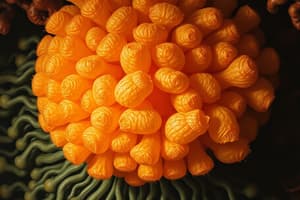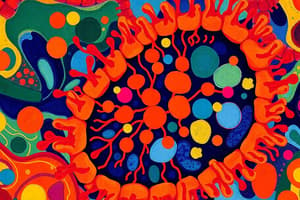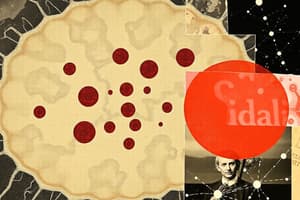Podcast
Questions and Answers
Enzymes responsible for adding glycans to proteins are called glycosyltransferases.
Enzymes responsible for adding glycans to proteins are called glycosyltransferases.
True (A)
What is the process that involves the addition of carbohydrate molecules to proteins?
What is the process that involves the addition of carbohydrate molecules to proteins?
- Proteolysis
- Glycosylation (correct)
- Sulfation
- Phosphorylation
Protein modification in the Golgi apparatus involves the cleavage of proteins into smaller peptides or individual amino acids, a process known as ____________.
Protein modification in the Golgi apparatus involves the cleavage of proteins into smaller peptides or individual amino acids, a process known as ____________.
Proteolysis
What is the term for the addition of sulfate groups to proteins?
What is the term for the addition of sulfate groups to proteins?
What is the main function of the cell wall?
What is the main function of the cell wall?
What is the primary component of cell walls in algae?
What is the primary component of cell walls in algae?
What is the difference between the primary wall and the secondary wall in plant cells?
What is the difference between the primary wall and the secondary wall in plant cells?
What is the middle lamella composed of?
What is the middle lamella composed of?
Plasmodesmata connect the cytoplasm of neighboring cells. (True/False)
Plasmodesmata connect the cytoplasm of neighboring cells. (True/False)
Study Notes
Protein Modification in the Golgi Apparatus
The Golgi apparatus is a complex organelle found in eukaryotic cells, responsible for processing and modifying proteins synthesized by the endoplasmic reticulum (ER). Protein modification is a crucial step in the Golgi apparatus, where proteins undergo various chemical changes to acquire their final structure and function.
Types of Protein Modification:
- Glycosylation: the addition of carbohydrate molecules (glycans) to proteins, resulting in glycoproteins. This process occurs in the medial Golgi cisternae and is essential for protein folding, stability, and cell-cell interactions.
- Sulfation: the addition of sulfate groups to proteins, which can affect their function and activity.
- Phosphorylation: the addition of phosphate groups to proteins, which can regulate their activity and interactions.
- Proteolysis: the cleavage of proteins into smaller peptides or individual amino acids, which can activate or inactivate proteins.
Enzymes Involved in Protein Modification:
- Glycosyltransferases: enzymes responsible for adding glycans to proteins during glycosylation.
- Sulfotransferases: enzymes responsible for adding sulfate groups to proteins during sulfation.
- Protein kinases: enzymes responsible for adding phosphate groups to proteins during phosphorylation.
- Proteases: enzymes responsible for cleaving proteins during proteolysis.
Regulation of Protein Modification:
- Compartmentalization: the Golgi apparatus is divided into distinct cisternae, each with its own set of enzymes and modification reactions, allowing for spatial regulation of protein modification.
- Enzyme localization: specific enzymes are localized to specific regions of the Golgi apparatus, ensuring that proteins are modified in a specific order and manner.
- Protein-protein interactions: interactions between proteins and enzymes can regulate the modification process, ensuring that proteins are modified correctly and efficiently.
Protein Modification in the Golgi Apparatus
Function of the Golgi Apparatus
- The Golgi apparatus is a complex organelle found in eukaryotic cells, responsible for processing and modifying proteins synthesized by the endoplasmic reticulum (ER)
Types of Protein Modification
- Glycosylation: the addition of carbohydrate molecules (glycans) to proteins, resulting in glycoproteins, essential for protein folding, stability, and cell-cell interactions
- Sulfation: the addition of sulfate groups to proteins, which can affect their function and activity
- Phosphorylation: the addition of phosphate groups to proteins, which can regulate their activity and interactions
- Proteolysis: the cleavage of proteins into smaller peptides or individual amino acids, which can activate or inactivate proteins
Enzymes Involved in Protein Modification
- Glycosyltransferases: enzymes responsible for adding glycans to proteins during glycosylation
- Sulfotransferases: enzymes responsible for adding sulfate groups to proteins during sulfation
- Protein kinases: enzymes responsible for adding phosphate groups to proteins during phosphorylation
- Proteases: enzymes responsible for cleaving proteins during proteolysis
Regulation of Protein Modification
- Compartmentalization: the Golgi apparatus is divided into distinct cisternae, each with its own set of enzymes and modification reactions, allowing for spatial regulation of protein modification
- Enzyme localization: specific enzymes are localized to specific regions of the Golgi apparatus, ensuring that proteins are modified in a specific order and manner
- Protein-protein interactions: interactions between proteins and enzymes can regulate the modification process, ensuring that proteins are modified correctly and efficiently
Cell Wall
- The cell wall is a non-living, rigid structure that forms an outer covering for the plasma membrane of fungi and plants.
- The cell wall provides shape to the cell, protects it from mechanical damage and infection, and facilitates cell-to-cell interaction.
- It also acts as a barrier to undesirable macromolecules.
- Algae cell walls are composed of cellulose, galactans, mannans, and minerals like calcium carbonate.
- In other plants, cell walls consist of cellulose, hemicellulose, pectins, and proteins.
Primary and Secondary Cell Walls
- The primary wall of a young plant cell is capable of growth.
- As the cell matures, the primary wall becomes less capable of growth and the secondary wall is formed on the inner side of the cell.
- The secondary wall is formed on the inner side of the cell, towards the plasma membrane.
Middle Lamella
- The middle lamella is a layer composed mainly of calcium pectate.
- It acts as a glue, holding neighboring cells together.
Plasmodesmata
- Plasmodesmata are channels that traverse the cell wall and middle lamella.
- They connect the cytoplasm of neighboring cells, allowing for communication and transport of molecules.
Studying That Suits You
Use AI to generate personalized quizzes and flashcards to suit your learning preferences.
Description
Learn about the crucial step of protein modification in the Golgi apparatus, where proteins undergo chemical changes to acquire their final structure and function.




